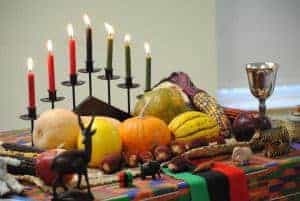 KWANZAA is not and was never intended to be a substitute for Christmas. Those who insist it is are either misinformed or harbor ulterior motives. When Dr. Ron Maulana Karenga created the celebration back in the 1960s, he made clear that the celebration was designed to provide to black Americans who were newly embracing the ideas of black pride and pan-Africanism a way of infusing those ideals into an annual cultural observance. He went to great lengths during those times to make sure people understood the celebration was neither political nor religious, but cultural.
KWANZAA is not and was never intended to be a substitute for Christmas. Those who insist it is are either misinformed or harbor ulterior motives. When Dr. Ron Maulana Karenga created the celebration back in the 1960s, he made clear that the celebration was designed to provide to black Americans who were newly embracing the ideas of black pride and pan-Africanism a way of infusing those ideals into an annual cultural observance. He went to great lengths during those times to make sure people understood the celebration was neither political nor religious, but cultural.
Kwanzaa (the Kiswahili word for “first fruits of the harvest”) is a week-long ceremony of cultural self-awareness that allows black Americans to explore and embrace traditional African community concepts. Some blacks observe the week formally, dressing up in African garb and wearing African hairstyles. Many, however, do not, and instead focus more on the philosophical, cultural and spiritual (not religious) aspects of the celebration.
Dr. Karenga who was a leading theorist of The Black Movement in the 1960’s, who wrote extensively on socio-political subjects. Because of that, many critics of the observance condemn it for being “revolutionary” in some manner, but clearly miss the point.
As pointed out on the official Kwanzaa website: “Kwanzaa is the only nationally celebrated, native, non-religious, non-political African-American holiday.”
The seven principles of Kwanzaa are each represented by a candle. Three red (for the blood shed) one black (for the people) and three green (for the land remembered).
One candle is lit each day of the observance and the principle– both its meaning and real-world application– is discussed by the family.
In order, the principles are:
- Umoja (unity) U-MO-JA (the black candle, placed in the middle)
- Kujicahgulia (self determi nation) KU-JI-CHA-GU-LIA (red, placed at the far left)
- Ujima (collective work and responsibility) U-JI-MA (red, placed second, from left to right)
- Ujamaa (cooperative econo-mics) U-JA-MA (red, placed third from left, and just to the left of the black candle)
- Nia (purpose) NIA (green, placed just to the right of the black candle)
- Kuumba (creativity) KU-UM-BA (green, placed second from right
- Imani (faith) I-MANI (green, placed at far right)
Kwanzaa is observed from December 26th through January 1st. Even though the brainchild of an African-American, Kwanzaa focuses on the rich cultural heritage of the African people who survived American slavery.
In January 2013, Wisconsin state Sen. Glenn Grothman called Kwanzaa a holiday that “almost no black people today care about,” and said iti s a “false holiday conjured up by a racist college professor and perpetuated by hard-core liberals”.
It was a curious statement, since how or why Kwanzaa was created has no bearing on whether or not it provides a meaningful, healthy, and positive experience for blacks
There are many websites containing information about the observance, activities and suggested African community rituals. We invite you to learn more about this observance and to expose your family to the celebration.


